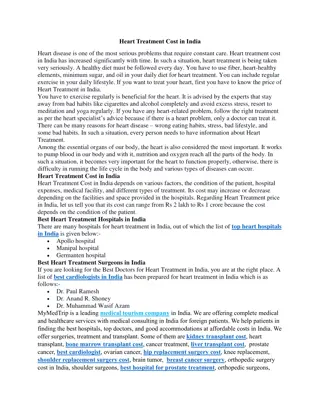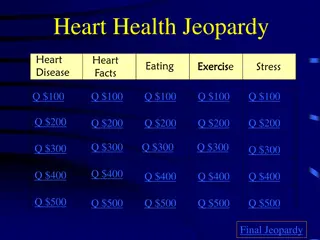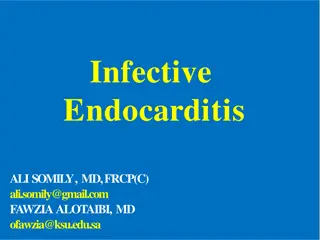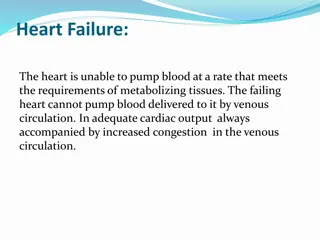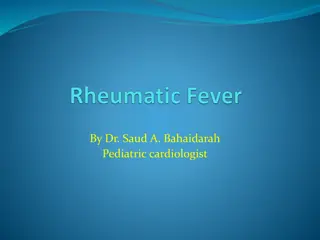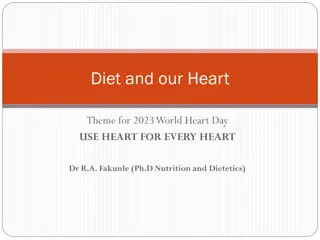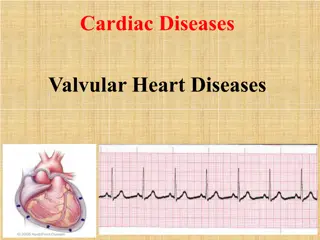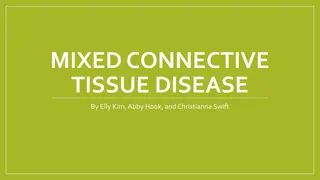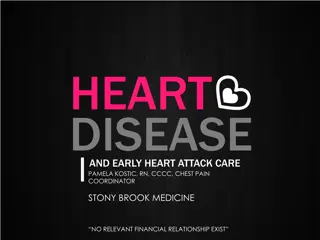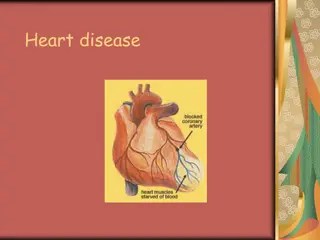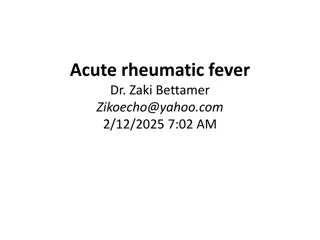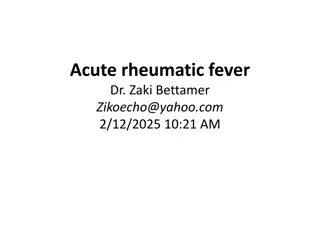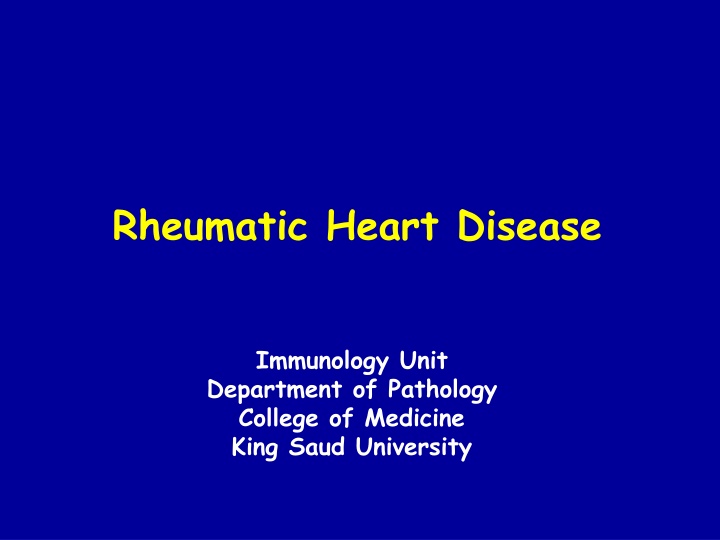
Rheumatic Heart Disease and Rheumatic Fever
Explore the immunological basis of rheumatic fever as a late complication of Streptococcal infection, including autoimmunity and rheumatic heart disease manifestations. Learn about the epidemiology, HLA susceptibility, and organism causing the disease.
Download Presentation

Please find below an Image/Link to download the presentation.
The content on the website is provided AS IS for your information and personal use only. It may not be sold, licensed, or shared on other websites without obtaining consent from the author. If you encounter any issues during the download, it is possible that the publisher has removed the file from their server.
You are allowed to download the files provided on this website for personal or commercial use, subject to the condition that they are used lawfully. All files are the property of their respective owners.
The content on the website is provided AS IS for your information and personal use only. It may not be sold, licensed, or shared on other websites without obtaining consent from the author.
E N D
Presentation Transcript
Rheumatic Heart Disease Immunology Unit Department of Pathology College of Medicine King Saud University
Objectives To understand basis of rheumatic fever as an immunologically mediated late complication of Streptococcal infection To know that autoimmunity results from production of cross reacting antibodies against Streptococcal antigens To describe rheumatic heart disease as one of the several manifestations of rheumatic fever To know the signs, symptoms, pathogenesis, treatment and prophylaxis of rheumatic heart disease
Rheumatic Fever Epidemiology of Rheumatic Fever (RF) ~3% of persons with untreated group A streptococcal pharyngitis develop rheumatic fever 15-20 million new cases a year in developing countries Risk factors Low standard of living Crowding
Rheumatic fever Individual (HLA) susceptibility is also important Antigen-presenting cells bearing the HLA-DR7 molecule from RHD patients preferentially recognize heart-tissue protein (Guilherme L, Kalil J. Ann N Y Acd Sci 2007,1107:426-433) Other views in the literature exist, due to + The various HLA-typing methods. + Ways of grouping the cases.
Rheumatic fever Rheumatic fever is an inflammatory disease which may develop after a Group A Streptococcal infection such as: Strep. throat infection or scarlet fever Can involve the heart, joints, skin, and brain It commonly appears in children ages 5 through 15
Organism Caused by group A streptococcus There is a latent period of ~3 weeks (1 5 weeks) between the group A streptococcal infection and the appearance of the clinical features of RF
Group A haemolytic streptococcus All cases associated with recent infection (e.g. pharyngitis) Antibody and cellular immune response cross-reacts with human connective tissue
Nimishikavi S, Stead L Streptococcal Pharyngitis Images in Clinical Medicine. NEJM 2005: 352:e10.
M proteins Adherence of Streptococcus pyogenes to host cells & inhibiting the host immune response Hyaluronic acid capsule: Camouflages the bacterium Streptokinases: Dissolve blood clots Peptidases: Degrades proteins involved in immune response Pyrogenic toxins: Stimulate fever, rash & shock Streptolysins: Lyse erythrocytes, leukocytes & platelets
PATHOGENESIS Rheumatic fever affect the peri-arteriolar connective tissue It is believed to be caused by antibody cross- reactivity This cross-reactivity is a Type II hypersensitivity reaction and is termed molecular mimicry
Group A streptococcus pyogenes has a cell wall composed of branched polymers which sometimes contain "M proteins " that are highly antigenic The antibodies which the immune system generates against the "M proteins" may cross react with cardiac myofiber protein myosin and smooth muscle cells of arteries, inducing cytokine release and tissue destruction This inflammation occurs through direct attachment of complement and recruitment of neutrophils and macrophages Fc receptor-mediated
Diagram illustrating the two hit theory of rheumatic heart disease. Group A streptococcal infection leads to the production of anti-group A carbohydrate antibody which cross-reacts with the valve endothelium as well as with the myocardium and up-regulates vascular cell adhesion molecule-1 (VCAM-1) on the valve endothelium. T cells adhere to the VCAM-1 on valve endothelium and extravasate into the valve.
Diagram illustrating the process of initial mimicry which leads to granuloma formation, gamma interferon production and scarring in the valve. After the initial process has developed inflammation in the valve, other proteins in the valve may then be recognized by the immune system leading potentially to epitope spreading and responses against other valve proteins such as vimentin and collagen. Molecular mimicry in the autoimmune pathogenesis of rheumatic heart disease by L. Guilherme; J. Kalil; M.W. Cunningham.
Immunofluorescent staining of heart muscle with serum obtained from an acute rheumatic fever patients
Pathophysiology During a Strep. infection activated antigen presenting cells such as macrophages present the bacterial antigen to helper T cells Helper T cells subsequently activate self reactive B cells and induce the production of antibodies against the cell wall of Streptococcus However the antibodies may also react against the myocardium and joints, producing the symptoms of rheumatic fever
Heart Up to 60% of patients with ARF progress to Rheumatic Heart Disease (RHD) only manifestation of ARF with significant potential to cause long-term disability and/or death The endocardium, pericardium, or myocardium may be affected (pancarditis) Valvular damage is the hallmark of rheumatic carditis. The mitral valve is almost affected Left ventricle has been cut open to display characteristic severe thickening of mitral valve, thickened chordae tendineae, and hypertrophied left ventricular
Joints (arthritis) This is usually polyarthritis, sometimes flitting from joint to joint (migratory), affecting the larger joints more than the smaller ones. Inflamed Keen Joint Swelling, redness and tenderness are the common findings and occasionally joint effusions.
Skin (Erythema Marginatum) Skin lesions: The classical erythema marginatum lesions with prominent margins slightly raised
Central nervous system (chorea) Sydenham's chorea Occurs in children, rare in adults The choreiform movements affect particularly the head and the upper limbs They may be generalized or restricted to one side of the body (hemi- chorea) Chorea eventually resolves completely, usually within 6 weeks likely due to molecular mimicry, with autoantibodies reacting with brain ganglioside
Subcutaneous nodules Subcutaneous nodules : These are painless, round, firm lumps overlaid by normal looking skin They range from a few millimeters to 1.5 cm in diameter, and are localized over bony prominences like the elbow, shin and spine. They sometimes last longer than a month
Investigation of Rheumatic Fever Anti-streptolysin O (ASO) titer At least 80% of patients with ARF have an elevated anti- streptolysin O titer at presentation Rising titer is more convincing Anti-DNAse B Anti-hyaluronidase test Throat culture for group A streptococci (obtain 2 or 3 cultures)
Rheumatic Fever Clinical Course Subsequent attacks Increased vulnerability to reactivation of disease with subsequent strep infections Same symptoms with each attack Carditis worsens with each attack Heart valves are frequently deformed (mitral) Heart failure develops after decades
Acute, recurring, chronic: Symptoms prone to recur with subsequent Strep. infections Chronic disease leads to fibrosis (chordae of heart valves + valve cusps) Stenotic mitral valve seen from left atrium Opened stenotic mitral valve
Treatment of Rheumatic Fever Treat first strep throat infection with penicillin Treat other manifestations symptomatically Prophylactic long term anti-strep therapy given to anyone who has had rheumatic fever
Take home message Rheumatic heart disease results from cross reacting antibodies binding the heart valves Repeated attacks of Streptococcal throat infection over the years damage heart valves resulting in either stenotic or incompetent heart valves Treatment involves surgical replacement of the damaged heart valves In patients with rheumatic fever long term administration of penicillin is recommended for prevention of future infections by group A Streptococcus


